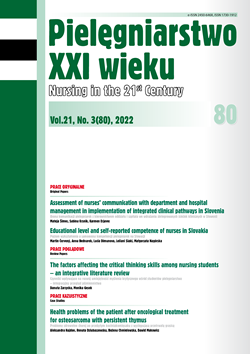Potraumatyczny rozwój u dzieci i młodzieży z cukrzycą typu 1
DOI:
https://doi.org/10.2478/pielxxiw-2022-0024Słowa kluczowe:
rozwój potraumatyczny, dziecko, cukrzyca, radzenie sobieAbstrakt
POTRAUMATYCZNY ROZWÓJ U DZIECI I MŁODZIEŻY Z CUKRZYCĄ TYPU 1
Cel pracy. Celem pracy było określenie częstości rozwoju potraumatycznego u dzieci i młodzieży z cukrzycą typu 1 oraz określenie związku ze strategiami radzenia sobie.
Materiał i metoda. Grupę badaną stanowiło 102 dzieci w wieku 12-18 lat z rozpoznaną cukrzycą typu 1. Projekt badania miał charakter przekrojowy. Do zebrania danych wykorzystano Kwestionariusz Potraumatycznego Rozwoju Dzieci (PTG-I) oraz Kwestionariusz Sposobów Radzenia Sobie (WCQ).
Wyniki. Sposoby radzenia sobie ze stresem związane są z późniejszym rozwojem potraumatycznym dzieci i młodzieży z cukrzycą typu 1. Najsilniejszą korelację stwierdzono między rozwojem potraumatycznym a strategiami radzenia sobie w poszukiwaniu wsparcia społecznego i planowym rozwiązywaniu problemów. Nie stwierdzono korelacji między rozwojem potraumatycznym a strategią radzenia sobie z ucieczką i unikaniem. Jednak strategia ta była najczęściej stosowana przez młodzież. Nie było różnicy w poziomie rozwoju potraumatycznego ze względu na płeć badanych i ich wiek, z wyjątkiem obszaru Siła Osobista oraz obszaru Zmiana Duchowna.
Wnioski. Ułatwienie przez pielęgniarkę skutecznych strategii radzenia sobie może mieć pozytywny wpływ na potraumatyczny rozwój dzieci i młodzieży z cukrzycą.
Bibliografia
1. Tedeschi RG, Shakespeare-Finch J, Taku K, et al. Posttraumatic growth: theory, research, and applications. New York: Routledge; 2018.
2. Berger R. Stress, trauma, and posttraumatic growth: social context, environment, and identitles. New York: Routledge; 2015.
3. Joseph S. Co nás nezabije...: možnosti posttraumatického růstu. Praha: Portál; 2017.
4. Paulík K. Psychologie lidské odolnosti. Praha: Grada; 2017.
5. Kučerová E. Jaspersův koncept mezních situací a Franklův smysl v utrpení – pozitivní pohledy na náročnou životní událost. Psychoterapie. 2015; 9 (1): 21-29.
6. Šumník Z, Brož J. Úskalí přechodu dětských pacientů s diabetem mezi dospělé [in:] Kvapil M. Diabetologie. Praha: Triton; 2015, s. 253-257.
7. Cherubini V, Skrami E, Iannilli A, et al. Disordered eating behaviors in adolescents with type 1 diabetes: A cross-sectional population-based study in Italy. Internat J Eat Disord. 2018; 51 (8): 890-898.
8. Bernstein CM, Stockwell MS, Gallagher MP, et al. Mental health issues in adolescents and young adults with type 1 diabetes: prevalence and impact on glycemic control. Clin Pediatr. 2013; 52 (1): 10-15.
9. Tran V, Wiebe DJ, Fortenberry KT, et al. Benefit finding, affective reactions to diabetes stress, and diabetes management among early adolescents. Health Psychol. 2011; 30 (2): 212-219.
10. Al-Yateem N, Subu MA, Al-Shujairi A, et al. Coping among adolescents with long-term health conditions: a mixed-methods study. Br J Nurs. 2020; 29 (13): 762-769.
11. Klimer RP, Gil-Rivas V, Tedeschi RG, et al. Use of revised posttraumatic growth inventory for children. J Trauma Stress. 2009; 22 (3): 248-253.
12. Edwards JR, O´Neill RM. The construct validity of scores on the ways of coping questionnaire: confirmatory analysis of alternative factor structures. Educ Psychol Meas. 1998; 58 (6): 955-983.
13. Meyerson, DA, Grant KE, Carter JS, et al. Posttraumatic growth among children and adolescent: A systematic review. Clin Psychol Rev. 2011; 2011 (31): 946-964.
14. Rassart J, Luckx K, Berg CA, et al. Longitudinal trajectories of benefit finding in adolescents with type 1 diabetes. Health Psychol. 2017; 36 (10): 977-986.
15. Taku K, McDiarmid L. Personally important posttraumatic growth in adolescents: The effect on self-esteem beyond commonly defined posttraumatic growth. J Adolesc. 2015; 44: 224-231.
16. Grey M. Coping skills training for youths with diabetes. Diabetes Spectr. 2011; 24 (2): 70-75.
17. Pisula E, Czaplinska Z. Coping with stress in adolescents with type 1 diabetes and their mothers. Eur J Med Res. 2010; 15(Suppl. II): 1-5.
18. Medveďová L. Zdroj stresu a zdroje jeho zvládania deťmi a adolescentmi. Psychológia a patopsychológia dieťata. 2004; 39 (2-3): 108-120.
19. Zeligman M, Varney M, Grad R, et al. Posttraumatic growth in individuals with chronic illness: the role of social support and meaning making. J Couns Dev. 2018; 96 (1): 53-63.
20. Prati G, Pietrantoni L. Optimism, social support, and coping strategies as factors contributing to posttraumatic growth: a meta-analysis. J Loss Prev Process Ind. 2009; 14 (5): 364-388.
Pobrania
Opublikowane
Numer
Dział
Licencja
Prawa autorskie (c) 2022 Autorzy

Utwór dostępny jest na licencji Creative Commons Uznanie autorstwa 4.0 Międzynarodowe.




